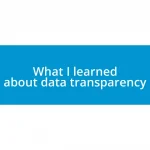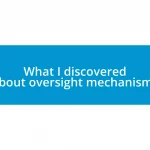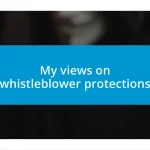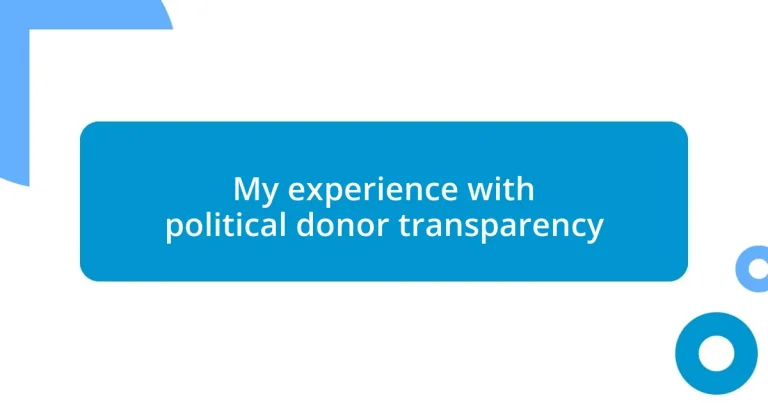Key takeaways:
- Political donor transparency is essential for building trust and accountability in the democratic process, allowing voters to understand who influences candidates.
- Transparency regulations vary widely, and there’s a need for comprehensive laws to cover all contributions, including smaller donations that may have significant impact.
- Engaging the community and utilizing technology, such as real-time tracking platforms, can enhance transparency and foster public dialogue about funding sources.
- Future trends indicate a push for legislative reforms and technological innovations, like blockchain, to improve donor transparency and public engagement.
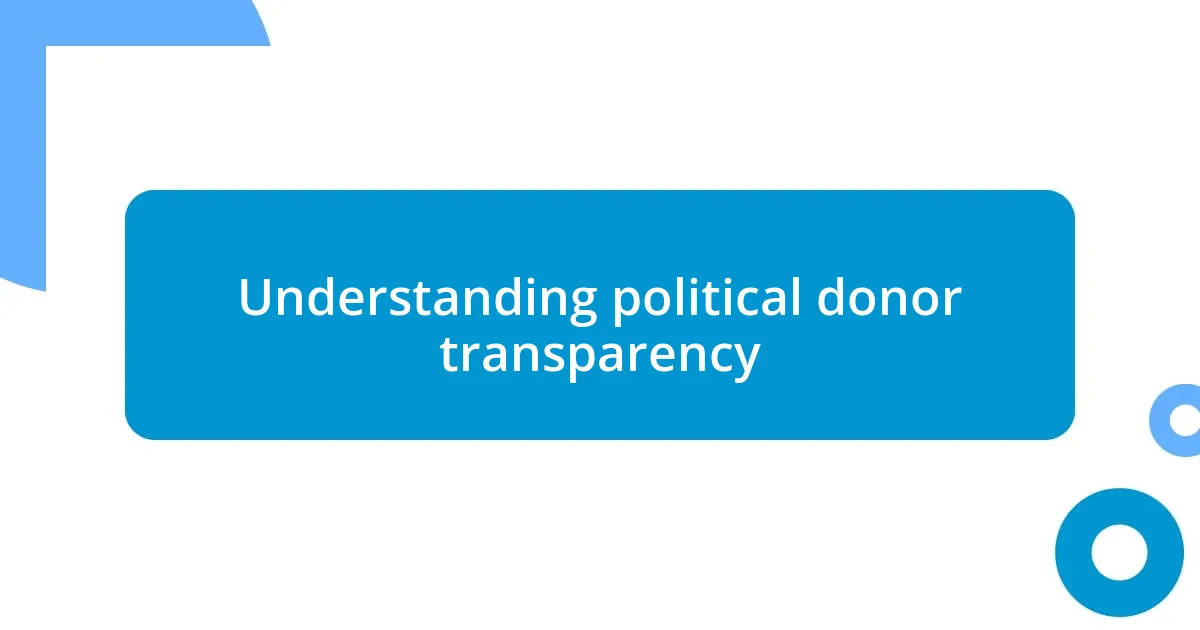
Understanding political donor transparency
Political donor transparency is crucial for ensuring that the electorate can hold their representatives accountable. I remember attending a town hall meeting where community members expressed frustration about mysterious funding sources for local campaigns. It struck me then how vital it is for voters to know who is backing whom; it creates a sense of trust—or, conversely, distrust.
In my personal experience volunteering for various campaigns, I often encountered this tension surrounding donor transparency. I recall one instance when a candidate refused to disclose their major donors, leading to skepticism among potential voters. It’s unsettling to think about how undisclosed funding can influence decisions that impact our lives directly, isn’t it?
When donors operate in the shadows, it can distort the democratic process, raising concerns about who truly holds the power. I’ve seen firsthand how transparency—or the lack thereof—can shape public perception and engagement. This makes me wonder: should we rely on candidates to be open, or is there a more systemic change we need to pursue?
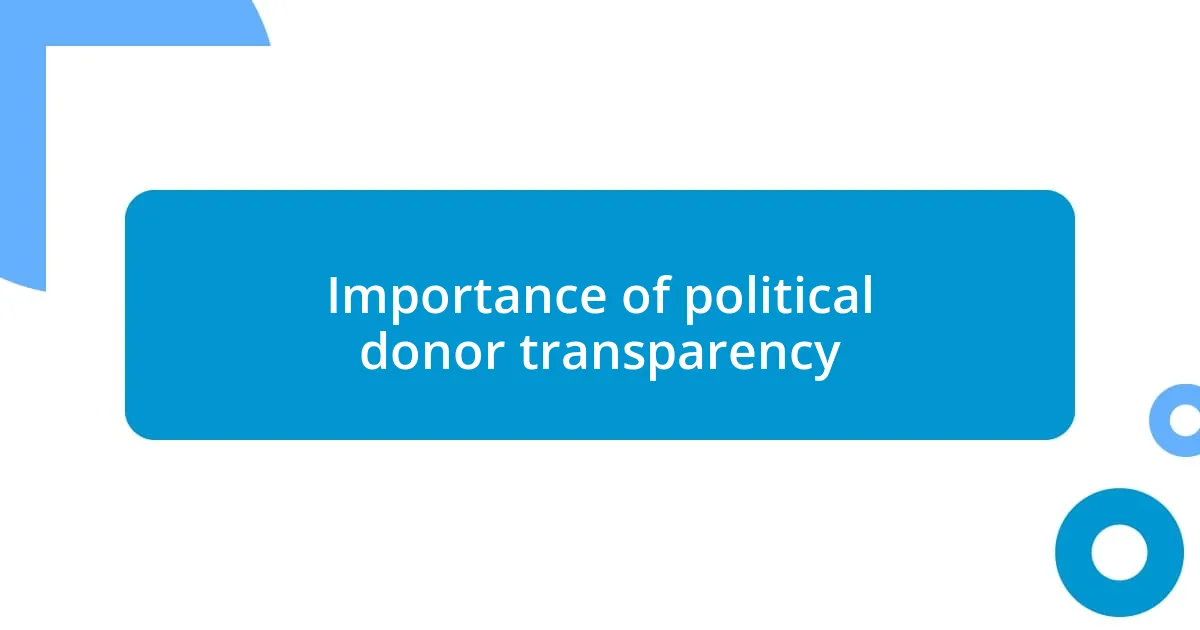
Importance of political donor transparency
Transparency in political donations isn’t just a technical requirement; it’s about building trust and safeguarding democracy. I recall a local election where a sudden influx of funds from unknown sources left many voters feeling uneasy. It’s disheartening when the motives behind financial support are shrouded in mystery. Knowing who is financially backing candidates not only demystifies the political landscape but also empowers the electorate to make informed decisions.
Consider these key reasons why donor transparency is essential:
- Accountability: Voters can assess whether candidates are beholden to special interests or the public.
- Trust Building: Open disclosure fosters trust, which is vital for civic engagement and active participation.
- Informed Decision-Making: Voters need to know financial influences to evaluate candidates’ positions objectively.
- Mitigating Corruption: Transparency can deter unethical behavior and potential corruption by exposing undue influences.
In my experience, when the funding sources were clear, it elevated discussions in our community; people felt more empowered to ask questions and engage constructively. It’s fascinating to see how simple transparency can ignite a more informed electorate, isn’t it?
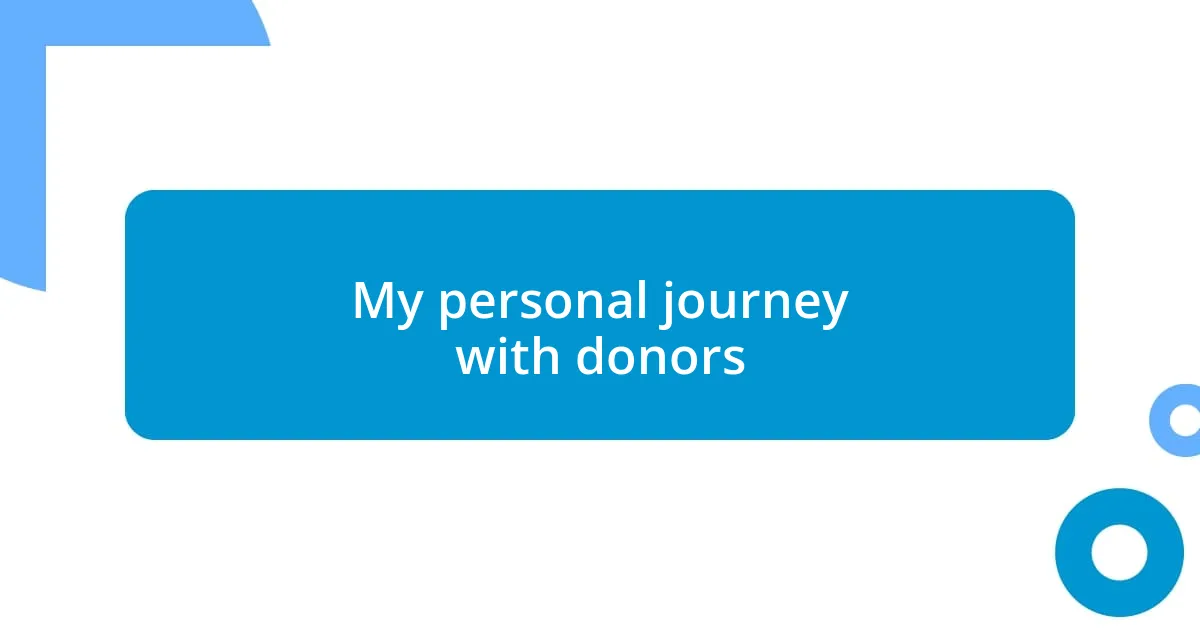
My personal journey with donors
I’ve often found myself reflecting on my interactions with political donors during my time as a grassroots volunteer. One particular evening, while organizing a fundraising event, I had the chance to speak directly with a donor who passionately defended their support for a candidate. Their conviction in the cause was inspiring, yet I couldn’t help but feel a pang of unease thinking about how their contributions could shape policy decisions that impact ordinary citizens like me. It was a powerful reminder of how personal motivations behind funding can directly affect our communities.
Another memorable experience involved a candidate who was open about their funding. I distinctly remember a heated debate at a local forum where they transparently discussed each donor’s influence. The atmosphere transformed; instead of skepticism, there was a palpable sense of engagement. I realized then that transparency not only alleviates fear but ignites curiosity and participation amongst the electorate. Observing this shift made me think: how often do we allow financial backing to dictate our political discourse?
In stark contrast, I recall a campaign plagued by uncertainty surrounding its finances. A crucial meeting had attendees whispering assumptions about hidden agendas. The tension in the room was thick; it seemed like everyone was on edge, unsure of whose interests were truly being served. This experience left a deep impression on me, highlighting how secrecy can severely hinder effective dialogue and trust within a community.
| Experience | Emotional Insight |
|---|---|
| Fundraising Event with Transparent Donor | Inspiration mixed with unease about influence |
| Candidate Open About Funding | Shift from skepticism to engagement |
| Campaign with Uncertain Finances | Tension, distrust, and assumptions among attendees |
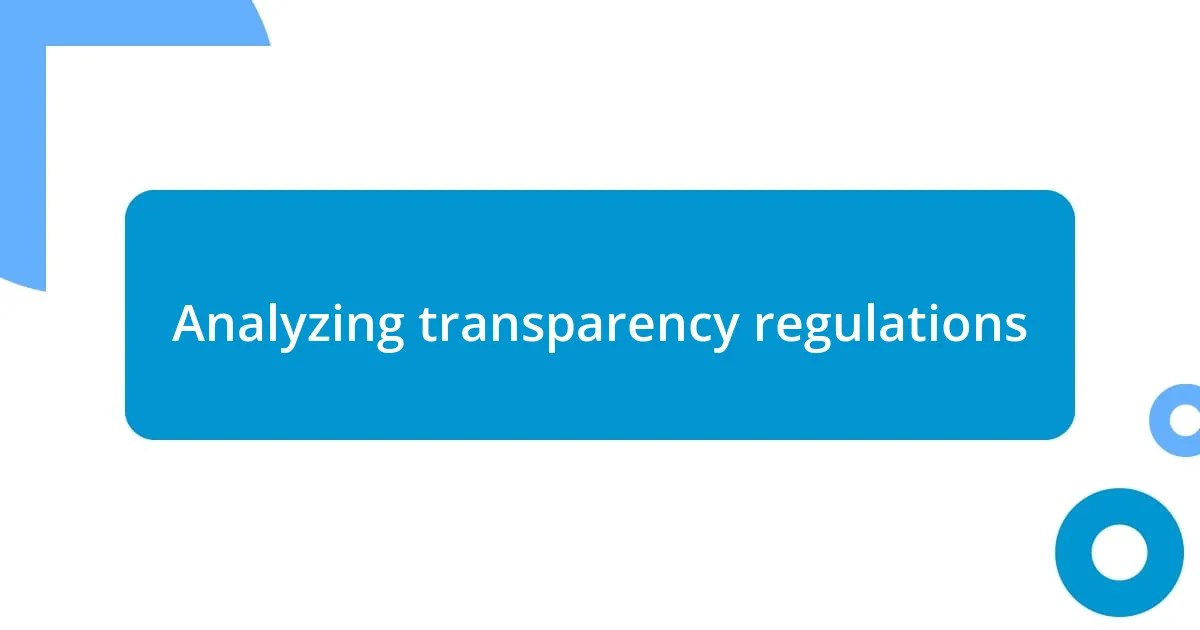
Analyzing transparency regulations
When we dive into the realm of transparency regulations, it’s easy to see how they lay the foundation for accountability in political donations. During my time observing local campaigns, I noticed that clear regulations could drastically alter a candidate’s approach to funding. For instance, when certain rules mandated public disclosure of donations above a specific threshold, candidates often felt pressured to be more selective with their fundraising efforts. How refreshing it was to witness candidates taking a stand on principles rather than simply seeking any monetary support they could get!
I also recall attending meetings where the conversations circled around the regulations themselves. It was astonishing to see how varied perceptions were about what constituted transparency. Many in the room believed that only large donations needed to be disclosed, while others argued that even smaller contributions should be reported to prevent hidden influences. This left me pondering: how much do these regulations truly cover? The gaps can be vast, and it made me realize that unless we advocate for comprehensive transparency laws, we risk ongoing obfuscation in the political donation process.
Moreover, I remember a candidate who proudly showcased their adherence to stringent transparency regulations. They shared their financial backers openly and invited questions during campaign events. The effect was palpable; voters felt more connected and trusting. Yet, I couldn’t shake the thought—what happens when candidates or parties circumvene these regulations? I often scanned the room, looking for indications of skepticism among the audience. The reality is that without consistent enforcement of these regulations, the cycle of suspicion could continue to undermine our faith in the democratic process.
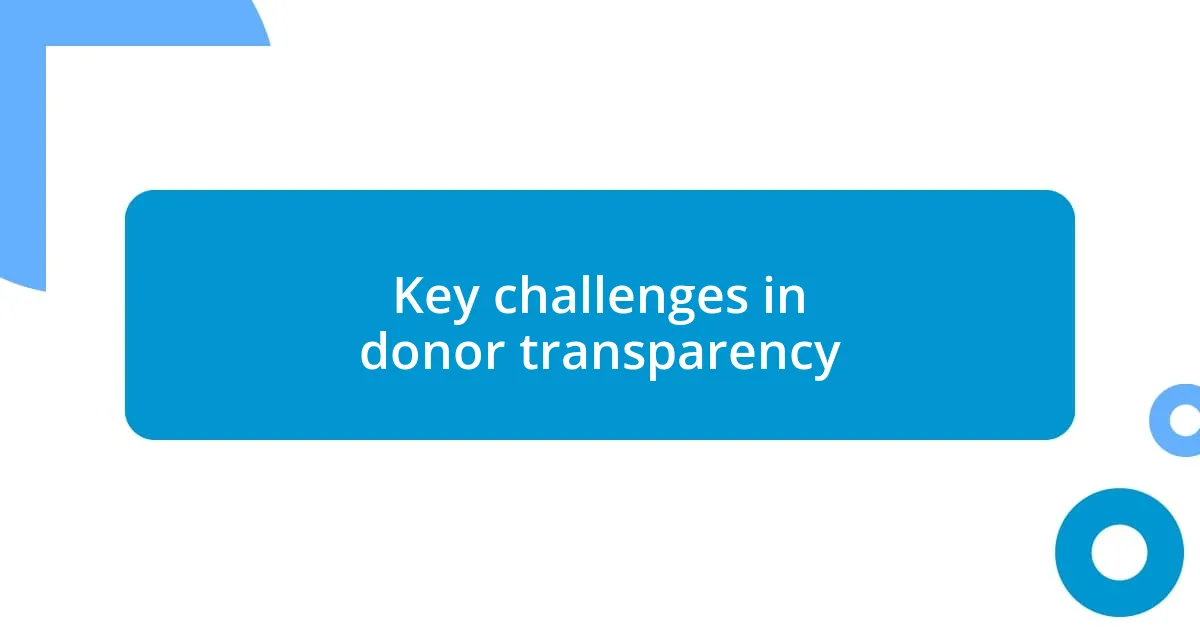
Key challenges in donor transparency
A significant challenge I’ve encountered in donor transparency is the difficulty in tracking small contributions. During one campaign I was involved with, we noticed many low-dollar donations that didn’t require public disclosure. While some might argue that these contributions are insignificant, I felt they often come from organized groups with their own agendas. This made me wonder: isn’t it crucial to understand where all money is coming from to truly grasp the influence it wields?
Another pressing issue is the widespread public misunderstanding of transparency regulations. I once participated in a community forum aimed at raising awareness. It was eye-opening to see how many attendees struggled to identify which donations required disclosure and what that meant for accountability. Hearing their confusion echoed my own initial experiences in this arena. It left me thinking—if we don’t fully understand the rules, how can we effectively advocate for better practices?
In addition, the inconsistency in enforcement of these regulations remains a persistent barrier. I remember feeling frustrated during a meeting where campaign officials spoke about navigating loopholes. Some candidates fabricated reports, while others genuinely sought to comply. It was a stark reminder that the space for interpretation can breed mistrust. This made me question whether the existing systems are truly equipped to hold donors accountable, and whether our electoral integrity hinges on the sincerity of those involved in the process.
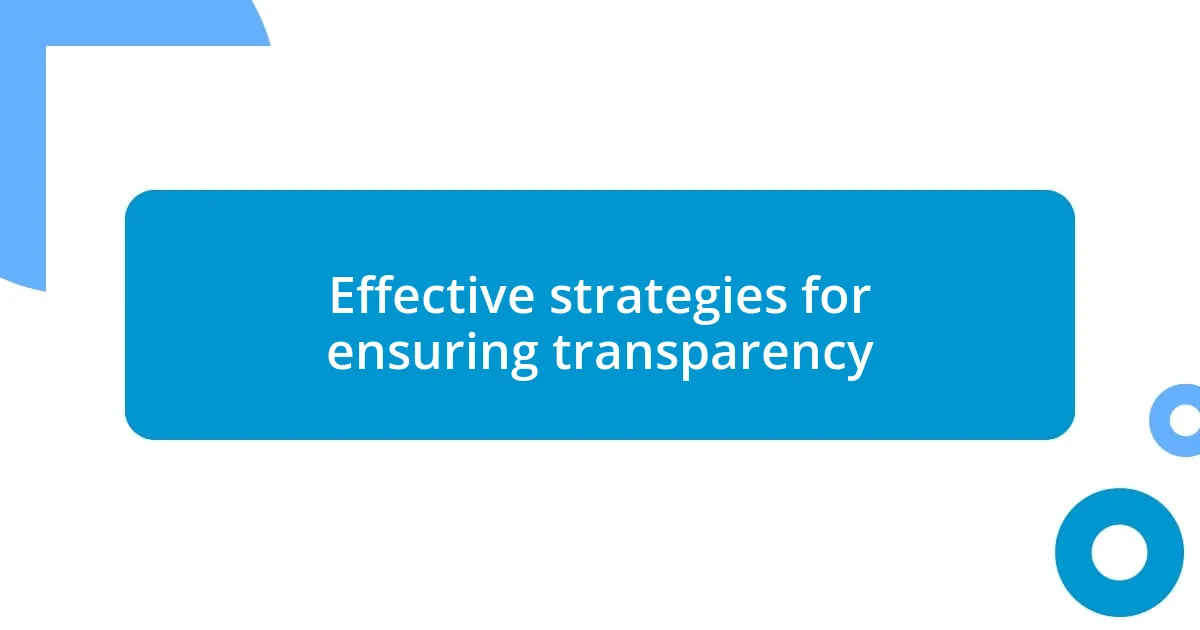
Effective strategies for ensuring transparency
To foster transparency, one of the most effective strategies I’ve seen in action involves leveraging technology. I recall a campaign that adopted an online platform for tracking donations in real time. This not only provided an accessible way for voters to view contributions but also encouraged other candidates to follow suit. It made me wonder—what if every campaign made their finances as transparent as this? The potential for trust-building is immense when people can see exactly who supports whom, without having to dig through stacks of paperwork.
Engaging the community is another crucial approach. During a local civic meeting, I witnessed a candidate host an open forum specifically about their funding sources. The atmosphere was filled with curiosity, and it really struck me how responsive the candidate was to each question posed. Wouldn’t it be wonderful if more political figures opened their doors like this? It seems that fostering dialogue can demystify the funding process, helping voters to understand not just the “who,” but also the “why” behind donations.
Lastly, advocating for stronger regulations must be a collective effort. During my years of activism, I found that teaming up with local watchdog organizations transformed our approach to transparency initiatives. These groups not only hold candidates accountable, but they also educate the public about their rights to know who finances their political landscape. This deeply resonates with me because when communities unite for a common cause, the push for accountability becomes a powerful movement. Could it be that our best chance at real change lies in this shared mission? I genuinely believe it does.
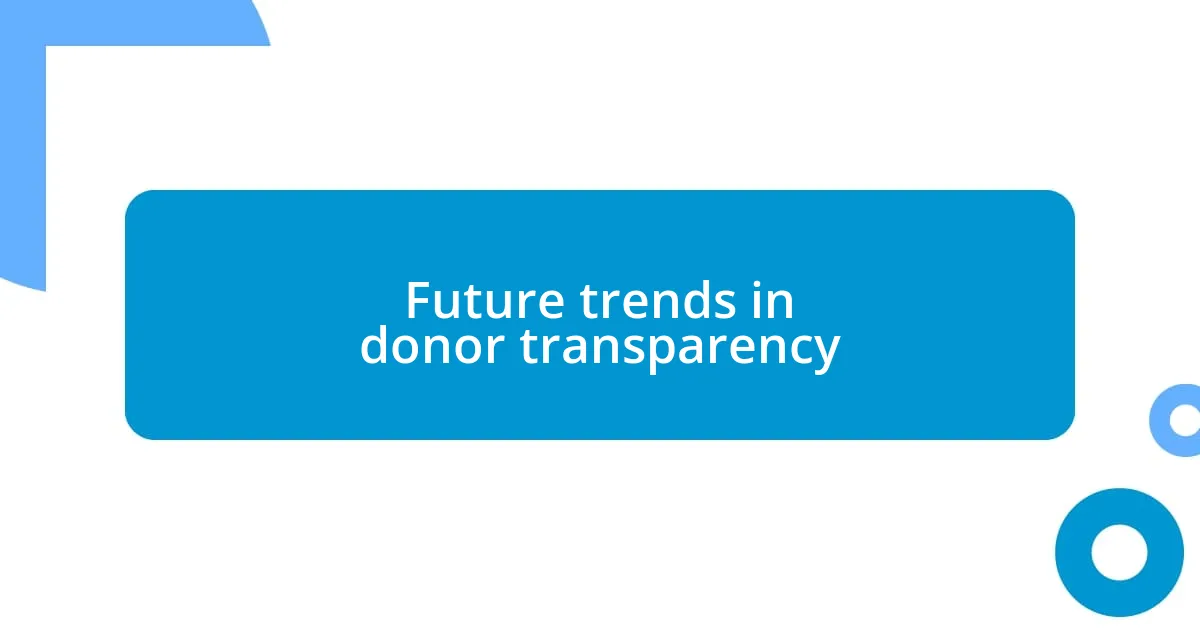
Future trends in donor transparency
As we look ahead, I see a trend toward increased legislative efforts aimed at enhancing donor transparency. In a recent experience at a state legislative hearing, I witnessed advocates pushing for bills that would make all campaign contributions, regardless of size, subject to scrutiny. This shift reflects a growing recognition that every dollar has the potential to influence policy, prompting me to ponder: will comprehensive transparency finally become the norm?
I’m also convinced that technology will play a pivotal role in shaping donor transparency. There was a fascinating moment when I attended a tech innovation event showcasing blockchain technology specifically tailored for political donations. It hit me then how this could create an unalterable record of who funds whom. Isn’t it exciting to think about a future where traceability is built into the fabric of our political financing?
Furthermore, I believe that public demand for transparency will continue to rise, fueled by a more engaged electorate. During a recent community meeting, I felt an electric energy as attendees passionately shared their concerns about undisclosed funding sources. Their voices inspired me to reflect: could this newfound activism become a catalyst for lasting change in our political system? The potential for a more informed and involved public on this issue is truly exciting, suggesting we might be on the brink of a more transparent political landscape.


